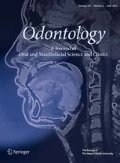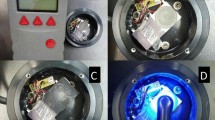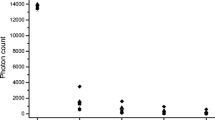Abstract
This study evaluated characteristics of light transmission, degree of monomer conversion and surface microhardness of bulk fill, conventional and fiber-reinforced resin based composites (RBCs) through different incremental thicknesses of resin composite. Working hypotheses was that there are differences in transmission of blue light through RBCs of different kinds and that the thickness of the increments influence the degree of monomer conversion of RBCs. Six bulk fill, three conventional nanohybrid, one short fiber reinforced and one flowable RBCs were evaluated. For each material, four different incremental thicknesses (1, 2, 3 and 4 mm) were considered (n = 5). The specimens were prepared in cylindrical Teflon molds that are open at the top and the bottom sides and cured for 40 s by applying the curing unit. After curing process, the specimens were ground with a silicon carbide paper with a grit size of 1200 and 4000, and then stored dry at 37 °C for 24 h. Light transmission, degree of monomer conversion, surface microhardness were measured and data were analyzed using ANOVA (p = 0.05). There were differences in light transmission of resin composites of various types and brands. Low-viscous bulk fill and short fiber-reinforced RBCs presented higher light transmission compared to resin composites of higher viscosity. Reduced light transmission and lower surface microhardness and DC % at bottom side of the specimen suggests that more attention needs to be paid to ensure proper curing of the resin composite in deep cavities.




Similar content being viewed by others
References
Sakaguchi RL, Douglas WH, Peters MC. Curing light performance and polymerization of composite restorative materials. J Dent. 1992;20:183–8.
Goracci C, Cadenaro M, Fontanive L, Giangrosso G, Juloski J, Vichi A, Ferrari M. Polymerizationefficiency and flexural strength of low-stress restorative composites. Dent Mater. 2014;30:688–94.
SDR. Instructions for use. Milford: Dentsply Caulk; 2012.
GC everX Posterior. everX Posterior technical manual. GC everX Posterior; 2013.
Bucuta S, Ilie N. Light transmittance and micro-mechanical properties of bulk fill vs. conventional resin based composites. Clin Oral Invest. 2014;18:1999–2000.
Garoushi S, Vallittu PK, Lassila LVJ. Short glass fiber reinforced restorative composite resin with semi-inter penetrating polymer network matrix. Dent Mater. 2007;23:1356–62.
Garoushi S, Säilynoja E, Vallittu PK, Lassila L. Physical properties and depth of cure of a new short fiber reinforced composite. Dent Mater. 2013;29:835–41.
Tauböck TT, Tarle Z, Marovic D, Attin T. Pre-heating of high-viscosity bulk-fill resin composites: effects on shrinkage force and monomer conversion. J Dent. 2015;43:1358–64.
Lehtinen J, Laurila T, Lassila LVJ, Tuusa S, Kienanen P, Vallittu PK, Hernberg R. Optical characterization of bisphenol-A-glycidyldimethacrylate-triethyleneglycoldimethacryalate monomers and copolymers. Dent Mater. 2008;24:1324–8.
Pianelli C, Devaux J, Bebelman S, Leloup G. The micro-Raman spectroscopy, a useful tool to determine the degree of conversion of light-activated composite resins. J Biomed Mater Res. 1999;48:675–81.
Watts DC, Amer O, Combe EC. Characteristics of visible-light-activated composite systems. Br Dent J. 1984;156:209–15.
dos Santos GB, Alto RV, Filho HR, da Silva EM, Fellows CE. Light transmission on dental resin composites. Dent Mater. 2008;24:571–6.
Ilie N, Bucuta S, Dreaenert M. Bulk-fill resin-based composites: an in vitro assessment of their mechanical performance. Oper Dent. 2013;38:618–25.
Flury S, Hayoz S, Peutzfeldt A, Hüsler J, Lussi A. Depth of cure of resin composites: is the ISO 4049 method suitable for bulk fill materials. Dent Mater. 2012;28:521–8.
Flury S, Peutzfeldt A, Lussi A. Influence of increment thickness on microhardness and dentin bond strength of bulk fill resin composites. Dent Mater. 2014;30:1104–12.
Garoushi S, Vallittu P, Lassila L. Depth of cure and surface microhardness of experimental short fiber-reinforced composite. Acta Odontol Scand. 2008;66:38–42.
Leprince JG, Palin WM, Vanacker J, Sabbagh J, Devaux J, Leloup G. Physico-mechanical characteristics of commercially available bulk-fill composites. J Dent. 2014;42:993–1000.
Musanje L, Darvell BW. Curing-light attenuation in filler-resin restorative materials. Dent Mater. 2006;22:804–17.
Masotti AS, Onofrio AB, Conceicao EN, Spohr AM. UV–Vis spectrophotometric direct transmittance analysis of composite resins. Dent Mater. 2007;23:724–30.
Emami N, Sjödahl M, Soderhölm K-JM. How filler properties, filler fraction, sample thickness and light source affect light attenuation in particulate filled resin composites. Dent Mater. 2005;21:721–30.
Le Bell AM, Tanner J, Lassila LV, Kangsniemi I, Vallittu PK. Depth of light-initiated polymerization of glass fiber-reinforced composite in a simulated root canal. Int J Prosthodont. 2003;4:403–8.
Alshali RZ, Silikas N, Satterthwaite JD. Degree of conversion of bulk-fill compared to conventional resin-composites at two time intervals. Dent Mater. 2013;29:213–7.
Czasch P, Ilie N. In vitro comparison of mechanical properties and degree of cure of bulk fill composites. Clin Oral Investig. 2013;17:227–35.
Ilie N, Hickel R. Investigations on a methacrylate-based flowable composite based on the SDR technology. Dent Mater. 2011;27:348–55.
Leprince J, Palin WM, Mullier T, Devaux J, Leloup G. Investigating filler morphology and mechanical properties of new-shrinkage resin composite types. J Oral Rehabil. 2010;37:364–76.
Chung KH, Greener EH. Correlation between degree of conversion, filler concentration and mechanical properties of posterior composite resins. J Oral Rehabil. 1990;17:487–94.
Bouschlicher MR, Rueggeberg FA, Wilson BM. Correlation of bottom-to-top surface microhardness and conversion ratios for a variety of resin composite composition. Oper Dent. 2004;29:698–704.
Kim EH, Jung KH, Son SA, Hur B, Kwon YH, Park JK. Effect of resin thickness on the microhardness and optical properties of bulk-fill resin composites. Restor Dent Endod. 2015;40:128–35.
Alrahlah A, Silikas N, Watts DC. Post-cure depth of cure of bulk fill dental resin-composites. Dent Mater. 2014;30:149–54.
Fleming GJ, Awan M, Cooper PR, Sloan AJ. The potential of a resin-composite to be cured to a 4 mm depth. Dent Mater. 2008;24:522–9.
Garcia D, Yaman P, Dennison J, Neiva G. Polymerization shrinkage and depth of cure of bulk fill flowable composite resins. Oper Dent. 2013;39:441–8.
Acknowledgments
Testing materials were provided by the manufacturing companies, which is greatly appreciated. Study is part of the activity of BioCity Turku Biomaterials Research Program (www.biomaterials.utu.fi).
Author information
Authors and Affiliations
Corresponding author
Ethics declarations
Conflicts of interest
Author Pekka Vallittu consults Stick Tech Ltd—Member of GC Group in RD. Other authors declare no conflicts of interests.
Rights and permissions
About this article
Cite this article
Garoushi, S., Vallittu, P., Shinya, A. et al. Influence of increment thickness on light transmission, degree of conversion and micro hardness of bulk fill composites. Odontology 104, 291–297 (2016). https://doi.org/10.1007/s10266-015-0227-0
Received:
Accepted:
Published:
Issue Date:
DOI: https://doi.org/10.1007/s10266-015-0227-0




